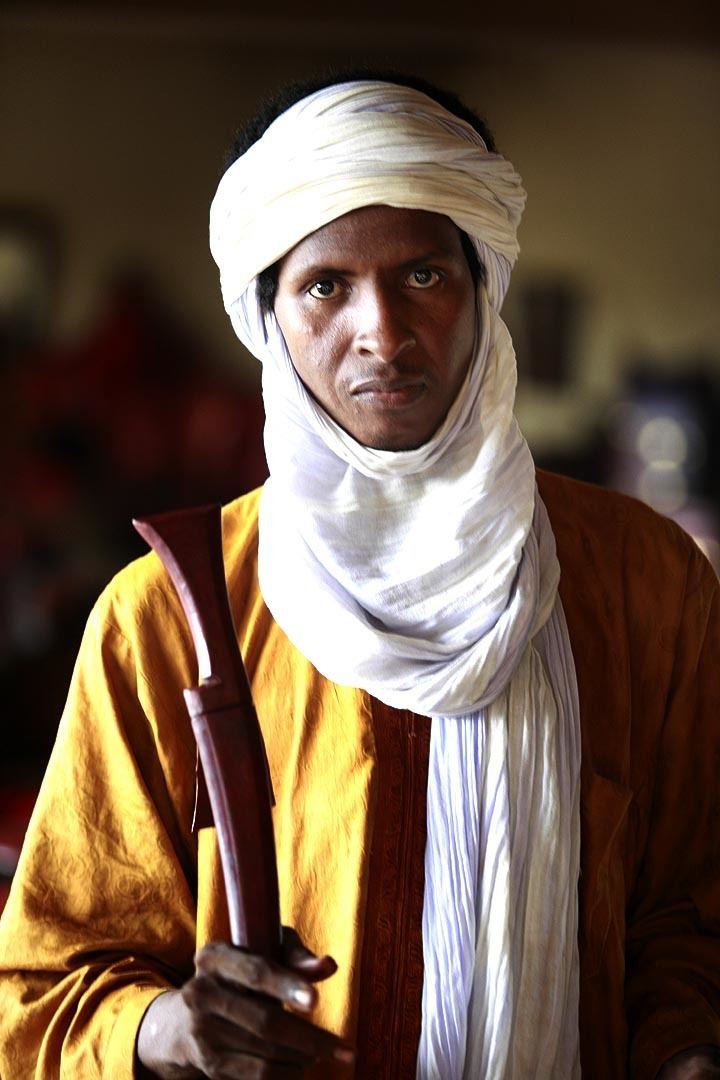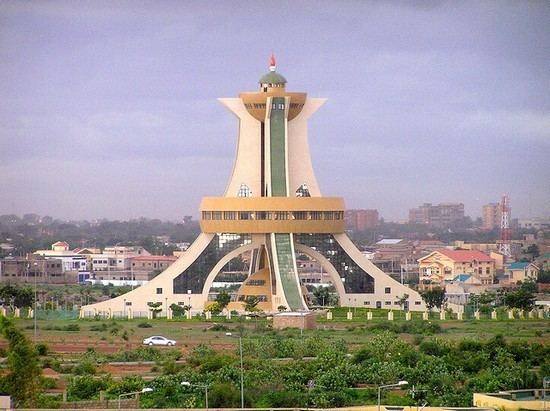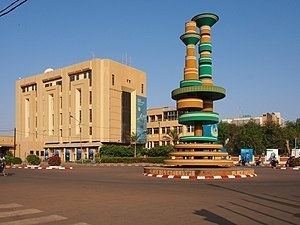Country Area 219.3 km2 | Population 1.475 million (2006) Region Centre Region | |
 | ||
Mayor Casimir Marin Ilboudo (since 2013) | ||
Map of Ouagadougou
Ouagadougou (; [waɡaduɡu]; Mossi: [ˈwɔɣədəɣʊ]) is the capital of Burkina Faso and the administrative, communications, cultural and economic centre of the nation. It is also the country's largest city, with a population of 1,475,223 (as of 2006). The city's name is often shortened to Ouaga. The inhabitants are called ouagalais. The spelling of the name Ouagadougou is derived from the French orthography common in former French African colonies.
Contents
- Map of Ouagadougou
- Best places to explore in africa abuja lagos ouagadougou
- Ouagadougou burkina faso
- History
- 2016 AQIM and Al Mourabitoun attacks
- Geography
- Climate
- Government
- Education
- Sport culture and leisure
- Art and crafts
- Health
- Transport
- Air transport
- Rail
- Economy
- Twin towns Sister cities
- Parks
- Other sites
- References

Ouagadougou's primary industries are food processing and textiles. It is served by an international airport and it is linked by rail to Abidjan in the Ivory Coast. There is no rail service to Kaya. There is a paved highway to Niamey, Niger, south to Ghana, and southwest to Ivory Coast. Ouagadougou was the site of Ouagadougou grand market, one of the largest markets in West Africa, which burned in 2003 and has since been reopened. Other attractions include the National Museum of Burkina Faso, the Moro-Naba Palace (site of the Moro-Naba Ceremony), the National Museum of Music, and several craft markets.

Best places to explore in africa abuja lagos ouagadougou
Ouagadougou burkina faso
History

The name Ouagadougou dates back to the 15th century when the Ninsi tribes inhabited the area. They were in constant conflict until 1441 when Wubri, a Yonyonse hero and an important figure in Burkina Faso's history, led his tribe to victory. He then renamed the area from "Kumbee-Tenga", as the Ninsi had called it, to "Wage sabre soba koumbem tenga", meaning "head war chief's village". Ouagadougou is a Francophone spelling of the name.
The city became the capital of the Mossi Empire in 1441 and was the permanent residence of the Mossi emperors (Moro-Naba) from 1681. The Moro-Naba Ceremony is still performed every Friday by the Moro-Naba and his court. The French made Ouagadougou the capital of the Upper Volta territory (basically the same area as contemporary independent Burkina Faso) in 1919. In 1954 the railroad line from Ivory Coast reached the city. The population of Ouagadougou doubled from 1954 to 1960 and has been doubling about every ten years since.
2016 AQIM and Al-Mourabitoun attacks
On 15 January 2016, gunmen armed with heavy weapons attacked the Cappuccino restaurant and the Splendid Hotel in the heart of Ouagadougou. 28 people were killed, while at least 56 were wounded; a total of 176 hostages were released after a government counter-attack into the next morning as the siege ended. Three perpetrators were also killed.
Geography
Ouagadougou, situated on the central plateau (12.4° N 1.5° W), grew around the imperial palace of the Mogho Naaba. Being an administrative center of colonial rule, it became an important urban center in the post-colonial era. First the capital of the Mossi Kingdoms and later of Upper Volta and Burkina Faso, Ouagadougou became a veritable communal center in 1995.
Climate
The climate of Ouagadougou is hot semi-arid (BSh) under Köppen-Geiger classification, that closely borders with tropical wet and dry (Aw). The city is part of the Sudano-Sahelian area, with a rainfall of about 800 mm (31 in) per year. The rainy season stretches from May to October, its height from June to September, with a mean average temperature of 28 °C (82 °F). The cold season runs from December to January, with a minimum average temperature of 16 °C (61 °F). The maximum temperature during the hot season, which runs from March to May, can reach 43 °C (109 °F). The harmattan (a dry wind) and the monsoon are the two main factors that determine Ouagadougou's climate. Even though Ouagadougou is farther from the equator, its hottest months' temperatures are slightly hotter than those of Bobo-Dioulasso, the second most populous city.
Government
The first municipal elections were held in 1956.
Ouagadougou is governed by a mayor, who is elected for a five-year term, two senior councillors, and 90 councillors.
The city is divided into five arrondissements, consisting of 30 sectors, which are subdivided into districts. Districts of Ouagadougou include Gounghin, Kamsaoghin, Koulouba, Moemmin, Niogsin, Paspanga, Peuloghin, Bilbalogho, and Tiendpalogo. Seventeen villages comprise the Ouagadougou metropolitan area, which is about 219.3 square kilometres (84.7 sq mi).
The population of this area is estimated to be 1,475,000 inhabitants, 48% of which are men and 52% women. The rural population is about 5% and the urban population about 95% of the total, and the density is 6,727 inhabitants per square kilometer, according to 2006 census.
Concerning city management, the communes of Ouagadougou have made the decision to invest in huge projects. This is largely because Ouagadougou constitutes a 'cultural centre' by merit of holding the SIAO (International Arts and Crafts fair) and the FESPACO (Panafrican Film and Television Festival of Ouagadougou). Moreover, the growing affluence of the villages allow for such investment, and the population's rapid growth necessitates it.
Education
Though literacy in Ouagadougou is not high, there are three universities in the city. The largest college is the state University of Ouagadougou which was founded in 1974. In 2010 it had around 40,000 students (83% of the national population of university students).
The official language in the city is French and the principal local languages are More, Dyula and Fulfulde. The bilingual program in schools (French plus one of the local languages) was established in 1994.
International schools include:
Sport, culture, and leisure
A wide array of sports, including association football, basketball, and volleyball, is played by Ouagadougou inhabitants. There are sports tournaments and activities organized by the local authorities.
There are a number of cultural and art venues, such as the Maison du Peuple and Salle des Banquets, in addition to performances of many genres of music, including traditional folk music, modern music, and rap.
Art and crafts
Several international festivals and activities are organized within the municipality, such as FESPACO (Panafrican Film and Television Festival of Ouagadougou), which is Africa's largest festival of this type, SIAO (International Art and Craft Fair), FESPAM (Pan-African Music Festival), FITMO (International Theatre and Marionnette Festival) and FESTIVO.
Health
Ouagadougou has both state and private hospitals. The two state hospitals in the city are the Centre hospitalier national Yalgado Ouedraogo (CHNYO) and the Centre hospitalier national pédiatrique Charles de Gaulle (CHNP-CDG), but there are also private hospitals. Despite that, the local population still largely can only afford traditional local medicine and the "pharmacopée".
Transport
Many residents travel on motorcycles and mopeds. The large private vendor of motorcycles JC Megamonde sells 50,000 motorbikes and mopeds every year.
Ouagadougou's citizens also travel in green cabs, which take their passengers anywhere in town for 200 to 400 CFA, but the price is higher after 10:00 pm and can then reach 1000 CFA.
Air transport
Ouagadougou Airport (code OUA) serves the area with flights to West Africa and Europe. Air Burkina has its head office in the Air Burkina Storey Building (French: Immeuble Air Burkina) in Ouagadougou.
Rail
Ouagadougou is connected by passenger rail service to Bobo-Dioulasso, Koudougou and Ivory Coast. As of June 2014 Sitarail operates a passenger train three times a week along the route from Ouagadougou to Abidjan. There are freight services to Kaya in the north of Burkina Faso and in 2014 plans were announced to revive freight services to the Manganese mine at Tambao starting in 2016.
Economy
The economy of Ouagadougou is based on industry and commerce. Some industrial facilities have relocated from Bobo-Dioulasso to Ouagadougou, which has made the city an important industrial center of Burkina Faso. The industrial areas of Kossodo and Gounghin are home to several processing plants and factories. The industry of Ouagadougou is sector that fuels urban growth, as people move to the city from the countryside to find employment in industry. The Copromof workshop in Ouagadougou sews cotton lingerie for the French label "Atelier Augusti."
Ouagadougou is an important commercial center. It is a center where goods are collected and directed to rural areas. With a large consumer base, large amounts of energy sources, raw materials for buildings, agricultural products and livestock products are imported to the city.
The economy is dominated by the informal sector, which is characterized by petty commodity production, and workers not necessarily having salaries. Traditional, informal trade is widespread and concentrated around markets and major roads, as well as in outlets in neighborhoods. There are also instances of modern economic practices with workplaces having qualified, stable labor forces, or more traditional forms of business such as family businesses.
The tertiary sector is also an important part of the economy. This comprises communications, banking, transport, bars, restaurants, hotels, as well as administrative jobs.
Twin towns – Sister cities
Ouagadougou is twinned with:
Parks
The Bangr-Weoogo urban park (area: 2.63 km2 (1 sq mi)), before colonialism, belonged to the Mosse chiefs. Considering it a sacred forest, many went there for traditional initiations or for refuge. The French colonists, disregarding its local significance and history, established it as a park in the 1930s. In 1985, renovations were done in the park. In January 2001, the park was renamed "Parc Urbain Bangr-Weoogo", meaning "the urban park of the forest of knowledge".
Another notable park in Ouagadougou is the "L'Unité Pédagogique", which shelters animals in a semi-free state. This botanic garden/biosphere system stretches over 8 hectares (20 acres) and also serves as a museum for the country's history.
"Jardin de l'amitié Ouaga-Loudun" (Garden of Ouaga-Loudun Friendship), with a green space that was renovated in 1996, is a symbol of the twin-city relationship between Ouagadougou and Loudun in France. It is situated in the center of the city, near the "Nation Unies' crossroads".
